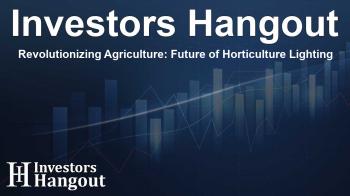Revolutionizing Agriculture: Future of Horticulture Lighting

Global Horticulture Lighting Market Overview
The horticulture lighting sector is on the brink of remarkable growth, with a projection to reach USD 25.06 billion by the end of the forecast period, according to latest analyses. In 2023, the market was valued at USD 7.14 billion and is expected to grow at an impressive compound annual growth rate (CAGR) of 17% from 2024 onward. This rapid transformation is largely attributed to the rising interest in energy-efficient solutions that significantly enhance crop yields.
Key Factors Driving Market Growth
Rising Demand for Controlled-Environment Agriculture
As urban populations expand, the demand for sustainable agricultural practices intensifies. Controlled-Environment Agriculture (CEA) is gaining traction, with enhanced practices like vertical farming and hydroponics rising to prominence. Horticultural lighting systems play a critical role in these methods, offering precise control over environmental variables to ensure optimal crop production throughout the year.
Technological Innovation in Lighting Solutions
The horticulture lighting landscape is being revolutionized by cutting-edge advancements in LED technology. Modern LED systems allow growers to customize light spectrums tailored for various growth stages—seedling, vegetative, and flowering. By significantly reducing energy consumption, these systems not only drive down costs but also improve crop quality. Smart lighting solutions, integrated with IoT and AI functionalities, enable real-time monitoring and adjustments, further boosting operational efficiency.
Sustainability Initiatives and Government Support
Governments globally are championing sustainability in agriculture through incentives like subsidies and grants aimed at promoting energy-efficient practices. Initiatives such as the European Union’s Green Deal exemplify support for environmentally sustainable technologies, including advanced horticultural lighting systems. Such measures cultivate a favorable market environment, encouraging innovators and investors to explore sustainable horticulture lighting solutions.
Challenges Facing the Horticulture Lighting Market
Financial Barriers and Market Access
Despite the numerous advantages of horticultural lighting systems, high initial capital costs pose a substantial barrier, especially for small to medium-sized cultivators. The substantial investment required for advanced systems often results in extended return on investment (ROI) periods, leading to hesitancy among potential adopters. Limited access to financing in emerging markets compounds these challenges, hindering the adoption of essential technologies for sustainable agricultural growth.
Awareness and Technical Expertise Gaps
While industrialized regions witness a surge in the adoption of horticultural lighting, many emerging markets remain unaware of its benefits. Small-scale farmers in regions such as Africa and Southeast Asia often lack access to the necessary technical knowledge, which stifles their ability to optimize these systems. Consequently, misconceptions surrounding the applicability of horticultural lighting impede widespread adoption.
Market Dynamics and Regional Insights
The European region commands a significant share of the horticulture lighting market, supported by government subsidies fostering energy-efficient practices and the proliferation of controlled-environment agriculture. This environment is conducive to R&D, propelling innovation and the optimization of practices in commercial greenhouses.
Competitive Landscape
The competitive landscape of the horticulture lighting market is characterized by major players such as Hubbell, Inc., Signify Holding, OSRAM GmbH, Koninklijke Philips NV, and Heliospectra AB. Each company is actively refining its technologies and strategies to maintain a competitive edge in this fast-evolving sector.
Frequently Asked Questions
What is the expected growth of the horticulture lighting market?
The horticulture lighting market is projected to reach USD 25.06 billion by 2031, growing at a CAGR of 17% from 2024 through 2031.
What are the main drivers of this market growth?
Main drivers include a rising demand for controlled-environment agriculture, technological advancements in LED lighting, and government support for sustainable practices.
What challenges does the horticulture lighting market face?
Challenges include high initial costs of systems, long ROI periods, and gaps in technical expertise, especially in emerging markets.
Who are the key players in the horticulture lighting market?
Key players include Hubbell, Inc., Signify Holding, OSRAM GmbH, Koninklijke Philips NV, and other leading companies in lighting solutions.
Why is controlled-environment agriculture important?
Controlled-environment agriculture offers a sustainable way of growing crops efficiently through technological innovations, allowing for year-round production regardless of external conditions.
About The Author
Contact Dominic Sanders privately here. Or send an email with ATTN: Dominic Sanders as the subject to contact@investorshangout.com.
About Investors Hangout
Investors Hangout is a leading online stock forum for financial discussion and learning, offering a wide range of free tools and resources. It draws in traders of all levels, who exchange market knowledge, investigate trading tactics, and keep an eye on industry developments in real time. Featuring financial articles, stock message boards, quotes, charts, company profiles, and live news updates. Through cooperative learning and a wealth of informational resources, it helps users from novices creating their first portfolios to experts honing their techniques. Join Investors Hangout today: https://investorshangout.com/
The content of this article is based on factual, publicly available information and does not represent legal, financial, or investment advice. Investors Hangout does not offer financial advice, and the author is not a licensed financial advisor. Consult a qualified advisor before making any financial or investment decisions based on this article. This article should not be considered advice to purchase, sell, or hold any securities or other investments. If any of the material provided here is inaccurate, please contact us for corrections.

